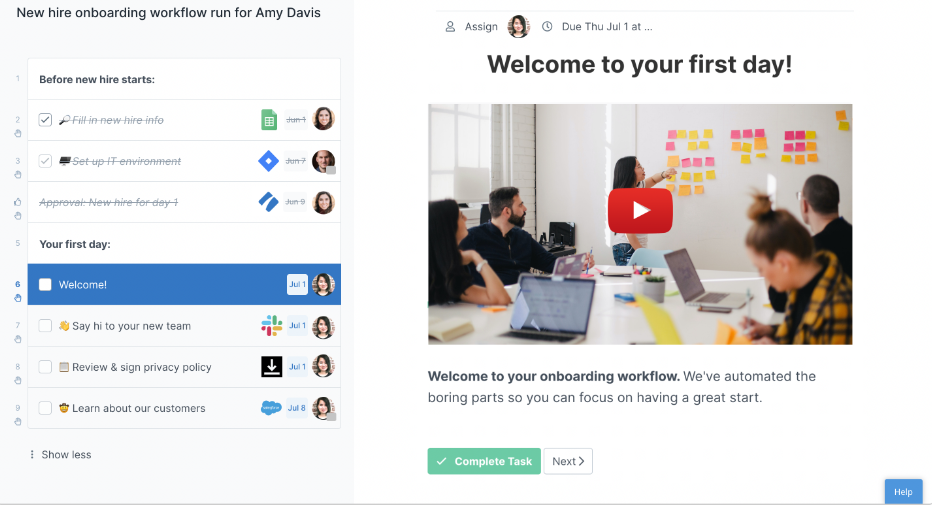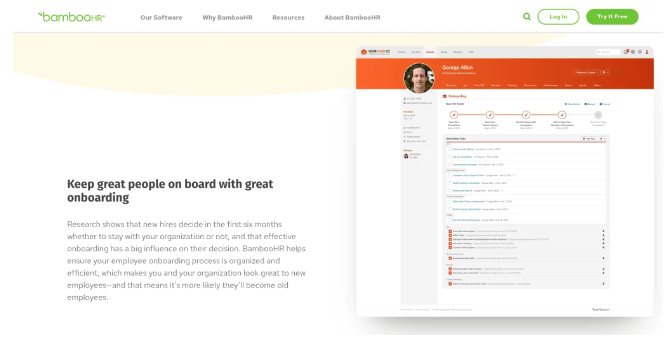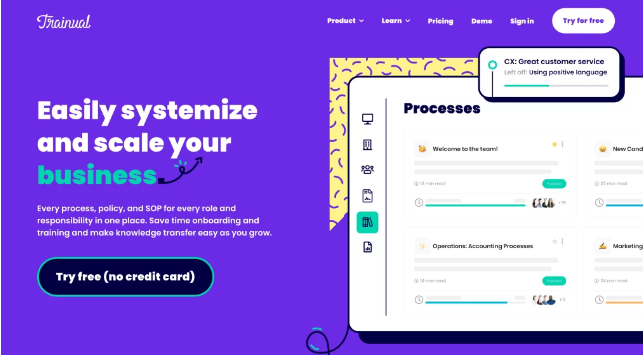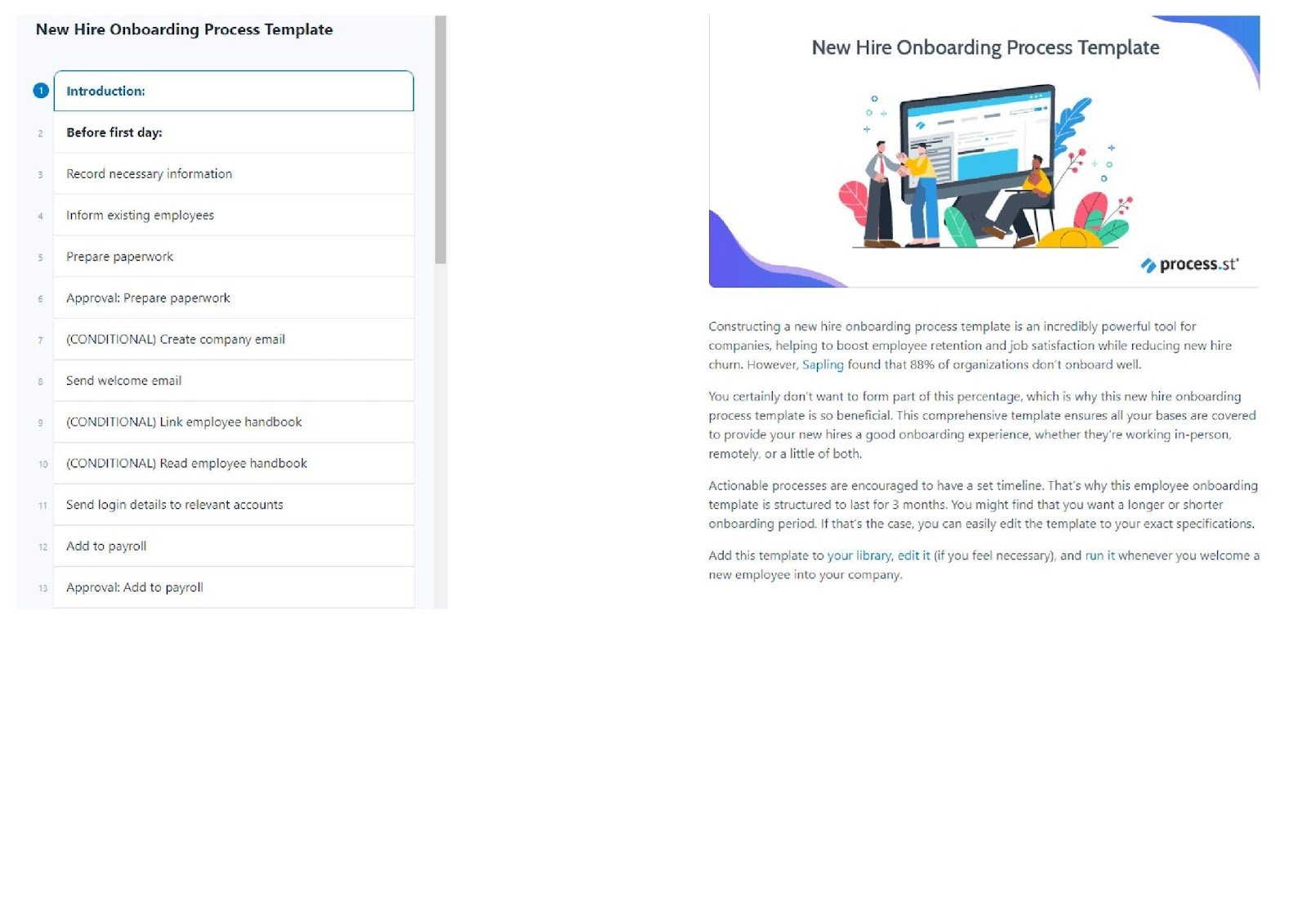Boost engagement, spark human connection, make new hires feel welcome with our no-code onboarding tool.
New Hires Orientation 101: Beginner’s Guide
New hires orientation goes hand-in-hand with onboarding to create a productive and happy cohort of employees.
Here at Process Street, we’ve been orienting new hires since day one. We understand that familiarizing them with our processes, people, and platform will result in success.
Our people stay with us for many years, and we believe that the bespoke onboarding processes we’ve created are some of the reasons why that is.
So, without further ado, let’s talk about new hires orientation!
Here’s the breakdown of what we’re going to cover:
- New hires orientation: The basics
- Why orienting new hires is important
- New hires orientation: 5 Stages
- Benefits of orienting new hires properly
- Challenges of orienting new hires
- New hires orientation best practices
- Software tools to help you orient new hires
- New hire orientation template
New hires orientation: The basics
New employee orientation usually takes place before and during their first day at work.
Unlike employee onboarding, orientation is often overlooked and thought of as redundant. However, the very first day can dramatically influence the employee’s willingness to remain with a company long-term.
So to reduce new hire churn and increase retention, you need to think strategically.
And that’s where new hire orientation comes into play.
By orienting new employees, you can start creating positive relationships with them right from the get-go.
Here’s a basic list of how to do it:
- Complete paperwork, gather data and personal information;
- Present the company values, vision, and mission;
- Make their role within your company explicitly clear;
- Let them know what’s expected of them;
- Introduce the new hire to their team;
- Give them a tour of the workplace;
- For remote companies, organize introductory calls with key people in your company;
- Get feedback on their orientation
Those are only the very basic steps, so keep on reading to get a better understanding of new hire orientation and its importance within your organization.
Why orienting new hires is important
As we’ve already covered, orienting new hires can benefit your company. But how does it benefit the new hire?
We all know how stressful starting a new job can be.
New hires often feel overwhelmed. But they also want some affirmation that the company they’ve just joined is right for them.
Those who are smoothly transitioned into their new role will become productive much quicker, too.
That crucial first day gives you the opportunity to make your new hire feel a part of the team. It can also serve as a training day to help them get settled into their new role quicker.
New hires orientation: 5 Stages
To truly master the orientation process, breaking it down into steps will help with planning and organization, and will also save a lot of time.
There are no hard and fast rules here; a lot depends on the nature of your business.
We’ve created 5 new hire orientation stages to show you how to go about creating a successful orientation program for your new employees.
Stage 1: Introductions
The main priority at this stage is to welcome your new hire into your company. You should also consider scheduling meetings/calls with key team members.
Follow this simple checklist to introduce your new hire:
- Schedule meetings with key team members;
- Provide a “welcome handbook” containing all the useful information for your new hire to learn;
- Explain how the company is structured and who is responsible for what;
- Ensure their login details, passwords, VPN, keys, badges, and IDs are all set and that they know how to login to the company systems;
- Give them a tour of the office, and explain where the emergency exits are located;
- Provide them with a mentor whom they can shadow for a day to get the feel of their new job;
- Inform them about the company benefits, and how to apply for the ones they’re interested in;
This list is not exhaustive, but it gives an idea of how your new hire’s first few hours may look like.
Stage 2: Paperwork
Many new employees are often bombarded with paperwork on their first day.
Even though necessary to complete, ensure that they’re given a deadline to hand everything in. This will make it less formidable for them, but will also reduce the risk of mistakes.
By offering to answer any questions and allowing the new hire to do this in their own time, you’ll start building trust with them straight away.
If they’re given a mentor, this would be a good time to have the two sit down and go through policies and documents together.
Stage 3: Brighten up new hires orientation with mixed media content
All orientation sessions should contain some form of training. This could be done by utilizing multiple tools and channels, and some are better than others.
For example, video introductions may present your company’s mission statement, culture, and history in a more structured way that an employee handbook would.
By making use of videos, you can also go through information quicker.
Some things to include in your training video could be:
- Company history, values, and culture
- Company structure and hierarchy
- Company benefits
- Company policies
- Quick introductions from the key stakeholders (this may be particularly useful in the case of larger organizations)
Videos are especially helpful when there’s more than one hire to orient, as it’ll save you time.
And because many people learn better when the materials are presented visually and verbally, videos allow them to remember more than they would from paperwork.
Stage 4: Provide new hires orientation training material
The next step in the new hire orientation process is to teach them more about their new job.
Again, videos can come in handy, but so can 1:1 training sessions.
You can supply:
- “How to” videos and documents;
- Provide job-specific training via online classes and quizzes;
- Give them “mini-tasks” that will teach them to their role;
It’s important to remember to space out these training sessions so that your new hire can digest all the information instead of quickly forgetting them.
Permit your new employee to complete the training sessions at their own pace, and let the first couple of days to be spent on just that.
Step 5: Ramp up new hires orientation gradually
Don’t be tempted to give your new hire too much to do in their first couple of weeks. Let them go through all the paperwork and training, and allow them to acclimate themselves to their role.
It’s a good idea to provide a clear structure for the week ahead so that the employee knows what to expect.
You could organize their diary as follows:
Day 1: Learning about the company
Day 2: Paperwork
Day 3: Meeting with the team / Training
Day 4: Training
Day 5: Trainng / First-week review and orientation feedback
By the end of their first week, the new hire will have a good level of understanding about their new role and the company as a whole.
Gathering feedback from them during their last day of orientation is also important, as you’ll learn what worked and what didn’t. That way, you canimprve the orientation process for your next hire.
Benefits of orienting new hires properly
There are numerous benefits of orienting new employees, and we’re going to cover some of the most important ones below.
It’s important to remember that, first and foremost, orientation serves as a foundation for your new employee and their career in your company. Get that foundation right and you’ll attract top talent that will stay with you for years to come.
So here are the top 8 benefits of orienting new hires properly:
- Provides the new hire with the information and tools needed to hit the ground running
- Helps new employees adapt to their new roles faster
- Improves employee retention
- Contributes to a productive workforce
- Saves the company time and money by reducing the costs associated with on-the-job training
- A well designed orientation programme will reduce the time needed to teach new hires their roles
- Makes new hires feel welcome and encourages to give feedback and share ideas
- Can reduce stress caused by starting a new job
Challenges of orienting new hires
As with any other process, orienting new hires comes with some challenges.
Some of these challenges arise even before the orientation and stem from the employers not providing enough clarity to the prospective employee.
So take a look at what these challenges are and how o overcome them.
Challenge 1: Lack of clarity – it’s important to make sure your new employees understand their role and responsibilities. If they’re doing things that end up being irrelevant to what was initially promised, they are sure to be looking for a better opportunity.
Challenge 2: Too much information – you’ll want to make the orientation process comprehensive, but don’t provide too much information at once. Remember that the new person has to learn a lot about your company, memorize the names of their new colleagues, and fill out tons of paperwork. So don’t expect them to do it all in a week.
Challenge 3: No investmenet in employee orientation – as with most things in life, new hire orientation will most likely cost you. So you may as well invest in the process to make it as effective as possible. Acquiring workflow management software, for example, won’t cost the earth, but can dramatically streamline the process.
New hires orientation best practices
According to this report, 45% of new hires have applied to other companies because of bad orientation/onboarding.
This is why new hire orientation is such a crucial time for most companies. Making the right first impression can reduce employee churn drastically.
But what are new hire orientation best practices that will help you retain your freshly acquired talent?
Create a checklist
There’s a lot that goes into orienting new hires, so you don’t want to make it more complicated for yourself.
By creating a checklist or a “new hire orientation template” (you’ll find a free template below), you can track all the hiring processes with ease.
Checklists, templates, and workflows help entire organizations remain organized and can streamline the orientation process considerably.
Schedule 1:1 meetings
Not everyone enjoys being put on the spot. Especially during their first days in a new job.
So by scheduling 1:1 calls or meetings with team members and stakeholders, you’ll put your new hire at ease and welcome them less informally.
What’s more, prioritizing 1:1’s over larger meetings allows for a better feedback exchange, as well as a quicker way to get to know everyone.
Automate
This goes back to utilizing checklists and workflows.
But by taking advantage of software and tools that automate the hiring and orientation process, you’ll save time, use fewer resources, and simplify approvals and requests.
Fully onboarding a new employee requires a lot of paperwork, data, and documentation. So you don’t want to be doing it manually!
Automating the process from hiring to onboarding is easy and completely fuss-free.
No more manual data entry or silly errors. Automations will truly transform your business.
Software tools to help you orient new hires
On the topic of business transformation -here’s our list of top software tools to orient new hires:
Process Street

If you’re after a comprehensive, yet easy-to-navigate platform, look no further than Process Street.
Design beautiful workflows that are sure to create a lasting impression on your new hire.
Connect tools and teams to construct a seamless orientation experience for your entire company – not just the new hire.
Choose from pre-made workflows, integrate with 100’s popular apps, and approve tasks in seconds thanks to our efficient platform.
Watch our quick product demo here!
BambooHR

As one of the most popular HR software, BambooHR lets you create a customizable experience, manage invoices and onboarding.
The interface is user-friendly and not overly complicated, making it a good choice for those new to HR software.
Thanks to its many features, BambooHR could be considered a one-stop-shop for most of your onboarding needs.
Trainual

Trainual is a great platform to develop employee handbooks and training videos.
By assigning employee onboarding handbooks you can rest assured that every new employee will get the most relevant information – regardless of the department they’re joining.
What’s more, Trainual lets you create org charts with pictures and information about every member of the company.
Trainual is also a good platform to communicate your missions and company values clearly and interestingly.
New hires orientation template
To make your orientation and onboarding process as smooth as possible, we’ve created a new hire orientation template.

The template covers everything from what to prepare before their first day to their third month of onboarding.
It’s a comprehensive guide to orientation and onboarding that will reinvent the way you deal with new employees.
It also allows you to integrate with other apps, such as Slack, Zapier, and more, to easily communicate, share data, and approve/reject tasks in a much smoother way.







